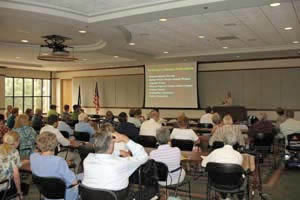|
 |
OTHER FORMS OF PARKINSON'S DISEASES
|
What is Parkinsonism?
Parkinsonism refers to any condition that causes a combination of the movement abnormalities seen in Parkinson's disease — such as tremors, slow movement, impaired speech or muscle stiffness — resulting from the loss of dopamine-containing nerve cells (neurons). Not everyone who has parkinsonism has Parkinson's disease. Other causes of parkinsonism can include:
- Lewy body dementia
- Stroke
- Encephalitis, inflammation of the brain usually caused by infection
- Progressive supranuclear palsy, a rare degenerative brain disorder
- Multiple system atrophy, a degenerative disorder that destroys nerve tissue
- Corticobasal degeneration, a rare neurological disease
- Certain medications, such as some anti psychotics and metoclopramide
- Head trauma, isolated or repeated, such as injuries sustained in boxing
The above information is from the Mayo Clinic web site CLICK HERE
|
 Photo Provided by
Photo Provided by
PBS Charlie Rose Brain Series Web site
|
Return to top of this page
What is Atypical Parkinsonism?
In the other forms of parkinsonism, either the cause is known or suspected, or the disorder occurs as a secondary effect of another primary neurological disorder that may have both primary and secondary symptoms of Parkinson's disease. These disorders, described as Parkinson's Syndrome, Atypical Parkinson's, or, simply, parkinsonism, may include the following:
- tumors in the brain
- repeated head trauma
- drug-induced parkinsonism - prolonged use of tranquilizing drugs, such as the phenothiazines, butyrophenones, reserpine, and the commonly used drug, metoclopramide for stomach upset.
- toxin-induced parkinsonism - manganese and carbon monoxide poisoning.
- post encephalitic parkinsonism - a viral disease that causes "sleeping sickness."
- striatonigral degeneration - the substantia nigra of the brain is only mildly affected, while other areas of the brain show more severe damage.
- parkinsonism that accompanies other neurological conditions - such as Shy-Drager syndrome (multiple system atrophy), progressive supranuclear palsy, Wilson's disease, Huntington's disease, Hallervorden-Spatz syndrome, Alzheimer's disease, Creutzfeldt-Jakob disease, olivopontocerebellar atrophy, post-traumatic encephalopathy, and dementia with Lewy bodies.
The above information is from The Ohio State University Medical Center web site CLICK HERE
|
Return to top of this page
What is Lewy Body disease?
Lewy Body Disease (LBD) is "not" a form of Parkinson's. Lewy Body Disease is comprised of a spectrum of diseases involving an array of dementia and motor symptoms. The disease is commonly referred to by a number of names, such as Lewy Body Disease, Lewy Body dementia, dementia with Lewy Bodies (DLB), or diffuse Lewy Body Disease.
Identifying Lewy Body Disease can be challenging if one is unfamiliar with its pathology, because the dementia is similar to that of Alzheimer's, while many symptoms appear to mimic Parkinson's. However, there are notable distinguishing characteristics. Unlike people with Alzheimer's or Parkinson's disease, patients with LBD exhibit:
- strong psychotic symptoms (hallucinations)
- extreme sensitivity to anti psychotic medications
- day-to-day symptom variability
In addition, Lewy Body Disease is twice as common in men as in women (Alzheimer's occurs equally in both genders) and is rarely genetically linked. Lewy Body Disease is actually the second most common cause of dementia, accounting for up to 20% all cases, according to the Lewy Body Dementia Association. There is not yet a cure, and symptoms tend to worsen over time.
Many of the symptoms of Lewy Body Disease bear a striking resemblance to Alzheimer's or Parkinson's. Since Lewy Body Disease is commonly misdiagnosed for both Parkinson’s and Alzheimer’s, it is helpful to understand how these diseases overlap. The similarity of symptoms between LBD and Parkinson’s disease, and between LDB and Alzheimer’s disease, can often make it difficult for a doctor to make a definitive diagnosis. In addition, Lewy bodies are often also found in the brains of people with Parkinson's and Alzheimer’s diseases. These findings suggest that either LDB is related to these other causes of dementia or that an individual can have both diseases at the same time.
For more information about Lewy Body Disease, please go to the following references
http://www.ninds.nih.gov/disorders/dementiawithlewybodies/dementiawithlewybodies.htm
http://helpguide.org/elder/lewy_body_disease.htm |
Return to top of this page
What is Progressive Supranuclear Palsy disease?
Progressive Supranuclear Palsy (PSP) disease is "not" a form of Parkinson's disease. PSP is a neurodegenerative brain diseases that has no known cause, treatment or cure. PSP affects nerve cells that control walking, balance, mobility, vision, speech, and swallowing. Five to six people per 100,000 will develop PSP. Symptoms begin, on average, when an individual is in their early 60's, but may start as early as in their 40's. PSP is slightly more common in men than women, but PSP has no known geographical, occupational or racial preference.
PSP patients often show alterations of mood and behavior, including depression and apathy as well as progressive mild dementia. It must be emphasized that the pattern of signs and symptoms can be quite different from person to person. The symptoms of PSP are caused by a gradual deterioration of brain cells in a few tiny but important places at the base of the brain, in the region called the brainstem.
PSP displays a wide range of symptoms including:
+ Loss of balance.
+ Changes in personality such as a loss of interest in ordinary pleasurable activities or increased irritability.
+ Weakness of eye movements, especially in the downward direction.
+ Weakened movements of the mouth, tongue and throat.
+ Slurred speech.
+ Difficulty swallowing.
PSP is often misdiagnosed because some of its symptoms are very much like those of Parkinson's disease, Alzheimer's disease, and more rare neurodegenerative disorders, such as Creutzfeldt-Jakob disease. The key to establishing the diagnosis of PSP is the identification of early gait instability and difficulty moving the eyes, the hallmark of the disease, as well as ruling out other similar disorders, some of which are treatable. Although PSP gets progressively worse, no one dies from PSP itself.
Research is ongoing for Parkinson's and Alzheimer's diseases. Better understanding of those common, related disorders will go a long way toward solving the problem of PSP, just as studying PSP may help shed light on Parkinson's and Alzheimer's diseases.
The above information is from the National Institute of Neurological Disorders and Stroke web site (NINDS) and from the Society for Progressive Supranuclear Palsy - CUREPSP.
For more information about PSP, please go to the following references
http://www.ninds.nih.gov/disorders/psp/psp.htm
http://www.psp.org/about/index.html
Return to "What Is Parkinson's?" page |
|
|





